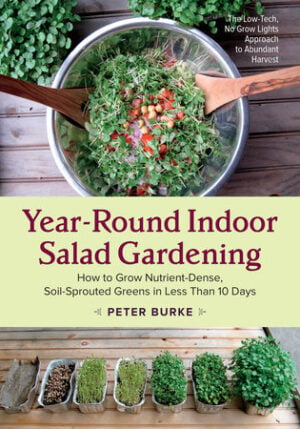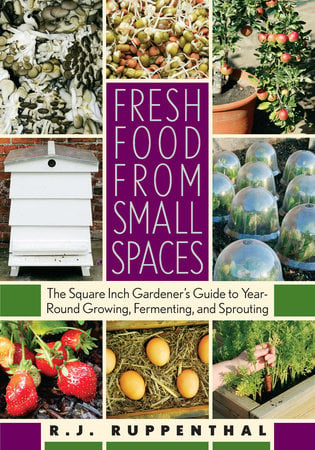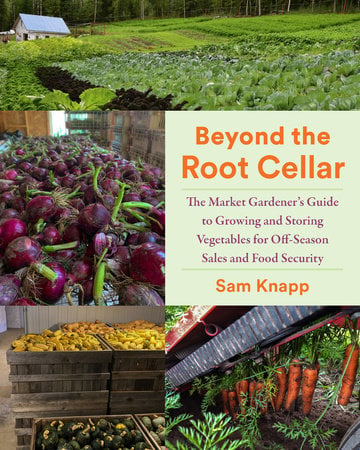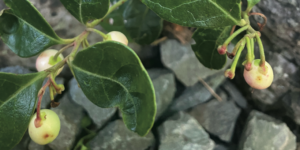How to Grow a Year-Round Indoor Salad Garden
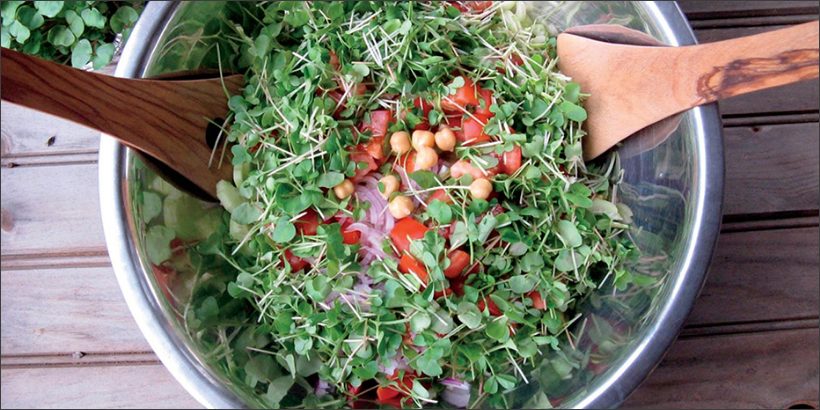
Does the cold weather have you dreaming about fresh greens and colorful salad? Grow and harvest sprouts indoors to make those dreams a reality!
Follow this quick start guide to year-round greens for fresh salad greens in just a couple of weeks!
The following is an excerpt from Year-Round Indoor Salad Gardening by Peter Burke. It has been adapted for the web.
Soil sprouts, microgreens, sprouts, and baby greens are all different versions of immature greens.
I have tried all of these methods and more in order to come up with what I needed for year-round indoor salad greens. This chapter is a rundown of the methods I used and the reasons I chose to grow soil sprouts over all the rest.
The Benefits of Soil Grown
Some might be wondering, “Why grow sprouts in soil?” You might ask, “Why not grow sprouts in jars like everyone else?”
When I first started experimenting with indoor garden techniques, I’d already been sprouting alfalfa and mung beans in jars. Building on this I expanded the types of seeds I sprouted. I added clover, lentils, various sprout mixes, and I even tried onion seeds because catalogs listed them.
I sprouted in jars, baskets, bags, and plastic sprouters, like the Biosta sprouter, all in an attempt to create an indoor garden to fill the salad bowl. One problem with these sprouts had no solution: My family was lukewarm to the salads I made.
They were OK with adding sprouts to a leaf salad, and they didn’t mind mung bean sprouts in a stir-fry with other vegetables, but that was enough sprouts for everyone.
What I was looking for were greens I could grow and use exclusively for a tossed green salad.
I liked these early traditional sprouts, but truth be told I wasn’t completely satisfied either. When I served the lush and tasty greens that grew from soil-grown sprouts, my family’s reaction told the story I wanted to hear. Everyone, including the kids, enjoyed the salads.
I had the variety of greens I was looking for—the soil-grown sprouts looked like regular tossed salad greens. I had achieved the look and texture I wanted.
10 Good Reasons to Sprout in Soil Versus Traditional Methods
Most gurus in the field agree that sprouts grown on soil are more nutritious, too. The suggestion is that the roots can draw full nutrients from the soil, compost, and sea kelp meal continuously as they grow, even in their very short growing cycle.
I haven’t found any research to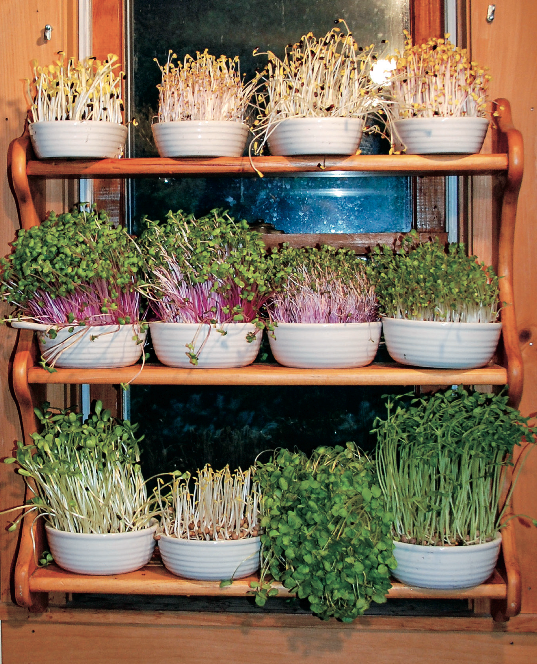 support this claim, but there’s tons of evidence that shows soil sprouts are good food. I don’t see any point in trying to make them “more better” to justify growing them on soil; there are plenty of good reasons to grow soil sprouts already!
support this claim, but there’s tons of evidence that shows soil sprouts are good food. I don’t see any point in trying to make them “more better” to justify growing them on soil; there are plenty of good reasons to grow soil sprouts already!
Here are my top reasons to grow this way:
1. Hulls drop off as sprouts grow
One great thing about growing soil sprouts is, there’s no need to wash the hulls off the sprouts. Hulls drop off on their own as the leaves grow and spread open.
With jar-grown sprouts, whether alfalfa or mung beans, washing to separate the hulls from the sprouts is a tedious job. Heaven knows I’ve cleaned enough of them.
There are tricks to the trade, but generally it takes time to get the hulls off. No matter what you do it seems like you can’t get rid of them all. Hulls mixed in with the greens tend to increase the spoilage factor and can affect the flavor of the sprouts.
With soil sprouts the hulls drop off as they grow and require only a minimum of washing. In some cases you might get hulls that cling to the seed leaf, but it is easy to pick off the few of them that linger, and it is nothing compared to having all of the hulls mixed in with the greens.
2. You can store right in the tray
When the soil sprouts are ready they can be “stored” right in their tray for a few extra days. Just water once a day, and they stay fresh and green until you are ready to harvest.
In fact, the soil sprouts continue to grow. In contrast, after a few days of storage, the tips of my jar-grown sprouts start to brown a little and the hulls tend to rot.
They have to go in the fridge if I am not ready to use them right away, and even then they need regular rinsing to keep them from spoiling. And with store-bought sprouts often the roots are brown and unappealing.
3. Easy to care for
The first 4 days you do nothing with soil sprouts. They stay in the dark on a shelf or in a cupboard. Once the seeds are planted moist soil and moist paper covers make for perfect conditions for the growing seeds, no watering necessary in the initial stage.
On the fifth day, when the cover comes off and the tray is in the light, you need to water only once a day. That is much easier than rinsing two or three times a day with jars, baskets, or bags.
4. Heartier greens
If you miss a watering, it’s not a catastrophe with soil sprouts; there’s enough moisture in the soil to carry sprouts through a day. If you really mess up and come home to limp greens, use soil sprout CPR—water the tray, put it in a plastic bag, and place it in the refrigerator.
This works well—they spring back to life! Not so with sprouts in a jar that spoil quickly without regular tending; there is no reviving them.
5. Creates a “greenspace”
It is great to see greens growing around the house and kitchen. Some of the seeds produce pink and purple stems and add a touch of life to the room. I sometimes put the trays in ceramic pots so I can vary the look of my indoor salad garden.
Even in small trays the greens are a welcome sight and mix in well with my wife’s houseplants. In the dead of winter with the greens growing, even thriving, they remind me that the cold is only for a while; soon I’ll be outdoors in the garden again!
The same is true if you’re in an apartment and don’t have a place to grow a garden. A few trays of fresh greens help to satisfy the gardening urge and provide a greenspace to the apartment atmosphere, whereas jars or a sprouter can offer little to the indoor landscape.
Growing soil sprouts in your house refreshes the air with oxygen just like regular houseplants. Could you ask for a better air freshener?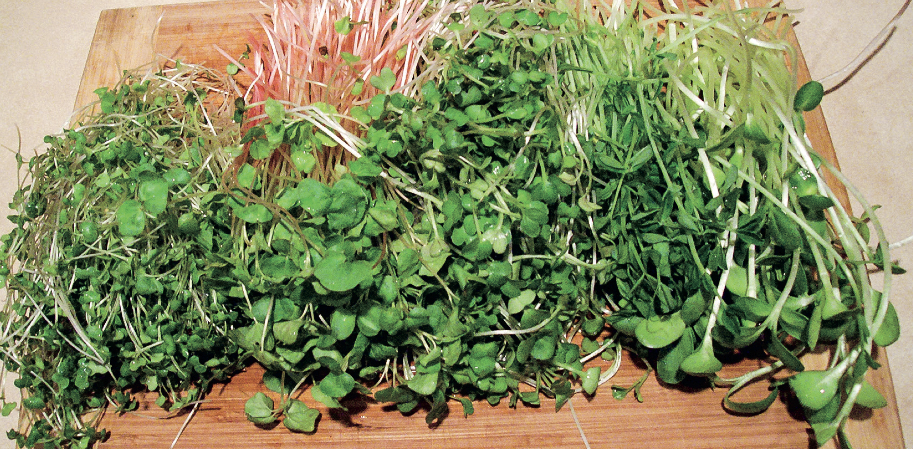
6. Visualize the harvest
Another thing I like about trays of fresh greens is that I can see what’s ready to harvest, making it easy to visualize what’s for dinner. I frequently choose the trays that I’ll harvest as I water them before dinner.
With the sprouts tucked away in jars, bags, and plastic trays, there’s no easy way to see which ones are nearing harvest time.
7. Much faster and easier than microgreens
If you’ve ever grown microgreens, you know they’re not ready in 7 days. If you’re lucky and choose the right varieties of greens, you can harvest them in about 21 days.
So in the time you could even begin to eat microgreens, you’ve already harvested soil sprouts three times and you’re planting your fourth set of sprout trays.
I figure it’s possible to harvest over a pound of greens from just 1 square foot of trays every week or so. Compare that to the size of any greenhouse, cold frame, or garden plot, and you’ll be clicking your heels and singing a song.
Plus microgreens need added light to grow indoors; without electric grow lights microgreens get long and spindly.
8. Simpler than hydroponics
Anything that has a recirculation pump seems more like a swimming pool than a garden to me. Don’t get me wrong: I like the hothouse and hydroponically grown tomatoes I buy at the store in the winter.
I’m glad someone has the patience and inclination to mess with the gear. But when I look at the equipment and the list of ingredients in the growing medium, I know I don’t have the time, the space, or the patience to use this technique. Just give me seeds and soil and I am all set to garden.
9. Great flavor
An all soil sprout salad is full of rich flavors and textures. Sunflower greens are crispy and have a mild nutty flavor. Buckwheat lettuce has a delicate texture and a sweet and sour flavor. Pea shoots have a sweet, pea taste. The thought of an all alfalfa sprout salad is not as appealing or flavorful to me.
Although it’s good and good for you, I guarantee my kids would look at me cross-eyed if I tried to sell it to them as a salad!
10. More color and texture
The bright-colored stems of soil sprouts make a beautiful and exciting salad mix. Bright red stems of Hong Vit radish, purple stems of the purple kohlrabi, bright pearly white of broccoli and sunflower, all combine in the salad bowl for a festival of color.
Add the soft pink and sometimes deep red of buckwheat and the bright orange of a grated carrot—there’s nothing like these salads.
Quick Start Guide to Year-Round Greens
Follow this quick start guide to year-round greens for fresh salad greens in just a couple of weeks!
Recent Articles
These snacks might be too darn cute to take a bite of! Brighten up snack time this winter using fruits and veggies we all know and love.
Read MoreWintergreen is the stunning evergreen groundcover that’s a game-changer for your garden! It’s cherished for its aromatic leaves, vibrant fall color & bright berries.
Read MoreGrow winter carrots for a sweeter & more flavorful harvest! Ditch the bland, store-bought carrots this winter! Grow your own winter carrots for a sweeter and more flavorful twist 🥕🥕
Read More

